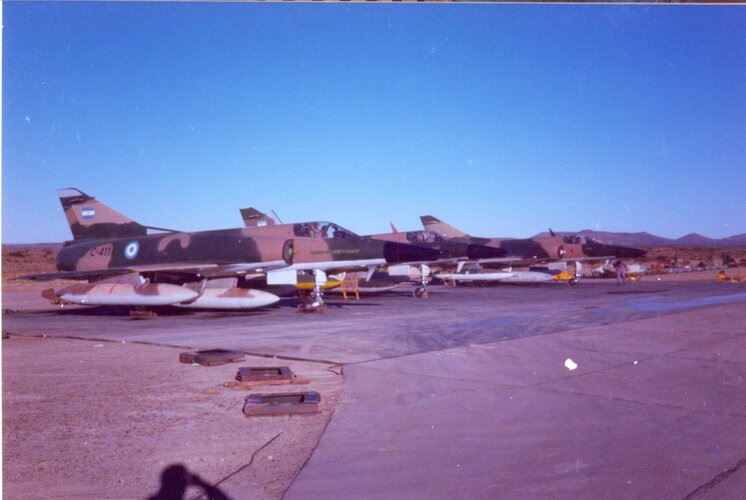You are using an out of date browser. It may not display this or other websites correctly.
You should upgrade or use an alternative browser.
You should upgrade or use an alternative browser.
Fighters of the 60s-70s: F-5 vs English Electric Lightning vs Mirage III
- Thread starter Ronny
- Start date
Comparing acceleration of English Electric Lightning F6 and Mirage III:
At 25000 feet.
In 1 minute
English Electric Lightning F-6 can accelerate from Mach 0.87-> Mach 1.2
Mirage III can accelerate from Mach 0.9 -> Mach 1.18
In 2 minutes
English Electric Lightning F-6 can accelerate from Mach 0.87 -> Mach 1.48
Mirage III can accelerate from Mach 0.9- Mach 1.33
In 3 minutes
Lightning F-6 can accelerate from Mach 0.87 -> Mach 1.68
Mirage III can accelerate from Mach 0.9- Mach 1.43
In 4 minutes
Lightning F-6 can accelerate from Mach 0.87 -> Mach 1.73
Mirage III can accelerate from Mach 0.9- Mach 1.55
At 35000 ft
In 1 minute
English Electric Lightning F-6 can accelerate from Mach 0.84-> Mach 1.12
Mirage III can accelerate from Mach 0.9 -> Mach 1.12
In 2 minutes
English Electric Lightning F-6 can accelerate from Mach 0.84 -> Mach 1.3
Mirage III can accelerate from Mach 0.9- Mach 1.3
In 3 minutes
Lightning F-6 can accelerate from Mach 0.84 -> Mach 1.52
Mirage III can accelerate from Mach 0.9- Mach 1.5
In 4 minutes
Lightning F-6 can accelerate from Mach 0.84 -> Mach 1.76
Mirage III can accelerate from Mach 0.9- Mach 1.7
Some will argue that , the Lightning F6 chart only consider AVON 301 engine, and above 20,000 ft, the AVON 302 will improve acceleration time by 10%, allowing the Lightning F-6 to be even better than Mirage III in acceleration. However, it is very important to remember that Mirage III acceleration chart is consider not a clean Mirage III but a Mirage III with 2 external fuel tank and not with the rocket booster that it can carry. At high altitude, the jet engine reduce thrust significantly while the rocket engine won't



At 25000 feet.
In 1 minute
English Electric Lightning F-6 can accelerate from Mach 0.87-> Mach 1.2
Mirage III can accelerate from Mach 0.9 -> Mach 1.18
In 2 minutes
English Electric Lightning F-6 can accelerate from Mach 0.87 -> Mach 1.48
Mirage III can accelerate from Mach 0.9- Mach 1.33
In 3 minutes
Lightning F-6 can accelerate from Mach 0.87 -> Mach 1.68
Mirage III can accelerate from Mach 0.9- Mach 1.43
In 4 minutes
Lightning F-6 can accelerate from Mach 0.87 -> Mach 1.73
Mirage III can accelerate from Mach 0.9- Mach 1.55
At 35000 ft
In 1 minute
English Electric Lightning F-6 can accelerate from Mach 0.84-> Mach 1.12
Mirage III can accelerate from Mach 0.9 -> Mach 1.12
In 2 minutes
English Electric Lightning F-6 can accelerate from Mach 0.84 -> Mach 1.3
Mirage III can accelerate from Mach 0.9- Mach 1.3
In 3 minutes
Lightning F-6 can accelerate from Mach 0.84 -> Mach 1.52
Mirage III can accelerate from Mach 0.9- Mach 1.5
In 4 minutes
Lightning F-6 can accelerate from Mach 0.84 -> Mach 1.76
Mirage III can accelerate from Mach 0.9- Mach 1.7
Some will argue that , the Lightning F6 chart only consider AVON 301 engine, and above 20,000 ft, the AVON 302 will improve acceleration time by 10%, allowing the Lightning F-6 to be even better than Mirage III in acceleration. However, it is very important to remember that Mirage III acceleration chart is consider not a clean Mirage III but a Mirage III with 2 external fuel tank and not with the rocket booster that it can carry. At high altitude, the jet engine reduce thrust significantly while the rocket engine won't
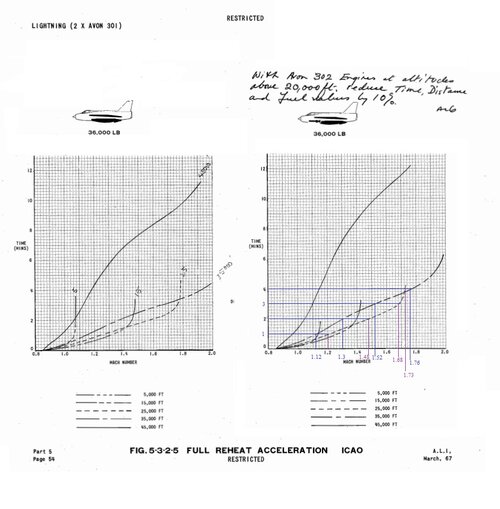

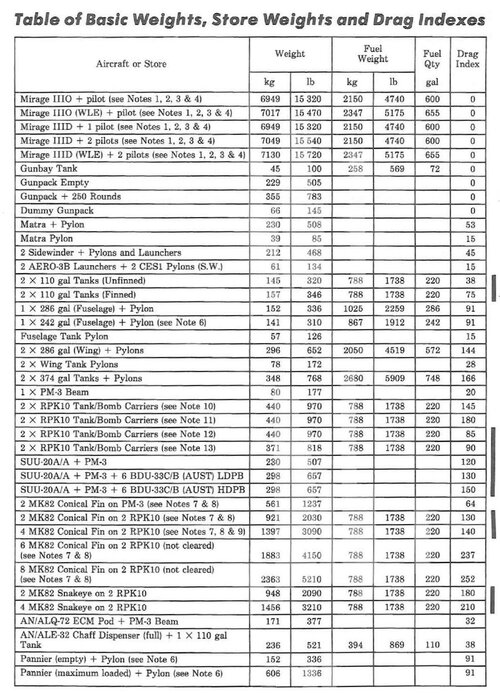
Last edited:
Taking about the booster, it is actually quite interesting, consider that it not actually a simple JATO system like on others aircraft. The rocket booster of Mirage can be used in combat in fact.
There are two version of rocket booster on Mirage III
SEPR 841, which use a separate fuel so to use it, the gun must be removed
SEPR 844, later version which use similar fuel as the aircraft main engine so the booster doesn't require the gun to be removed
The booster has 2 mode
Mode 1: generate 1500 kg of thrust in 80 seconds
Mode 2: generate 750 kg of thrust in 140 seconds



There are two version of rocket booster on Mirage III
SEPR 841, which use a separate fuel so to use it, the gun must be removed
SEPR 844, later version which use similar fuel as the aircraft main engine so the booster doesn't require the gun to be removed
The booster has 2 mode
Mode 1: generate 1500 kg of thrust in 80 seconds
Mode 2: generate 750 kg of thrust in 140 seconds

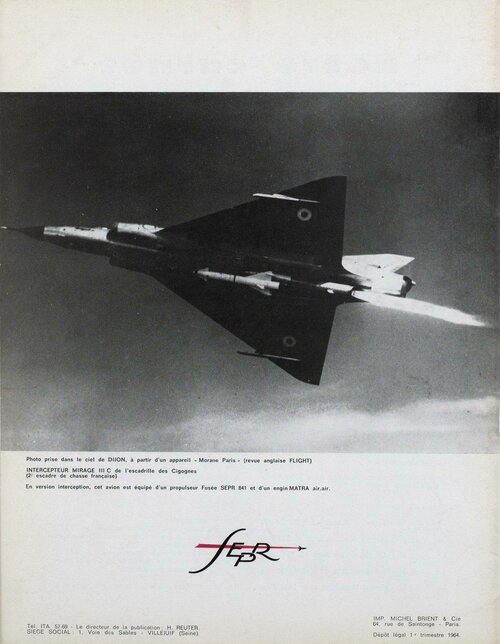

You are right,while the Lightning F6 has very good boundary thrust limit and seem to be able to generate decent amount of lift.
And with respect the Lightening was not known as a particularly agile dogfighter, even in it’s day.
The structure limit is quite low
F-5E structure limit at 7.33G
Mirage III structure limit at 6.77 G
Lightning F6 structure limit at 6G

- Joined
- 27 September 2006
- Messages
- 6,399
- Reaction score
- 6,780
A bit of a tangent but how often in the 60s and later did jet fighters with missiles literally "dogfight"?
Obviously the USAF and USN mixed it with N VNAF and the Israelis with Egypt, Syria (and others?). But has the RAF ever fought a jet dogfight? (Suez?) or France?
India Vs Pakistan?
Obviously the USAF and USN mixed it with N VNAF and the Israelis with Egypt, Syria (and others?). But has the RAF ever fought a jet dogfight? (Suez?) or France?
India Vs Pakistan?
_Del_
I really should change my personal text... Or not.
- Joined
- 4 January 2012
- Messages
- 1,315
- Reaction score
- 1,807
There have been many, including India and Pakistan that covers that period. Later skirmishes in the Falklands, and even the Gulf War when missiles and sensors were much more capable. If fights can devolve into a furball in the 90's, you can be sure it would be happening (and did as shown by Vietnam, the ME, India-Pakistani conflicts, et al) through the 50's-70's.
Lightning F6 might climb faster but F-16 is so much better in straight line accelerationBVR: clearly Mirage because only it can carry long range missile
WVR: Electric lighting because it can boom and zoom with acceleration on pair with F-16
At 15000 ft
Clean Lightning F6 need 1 minute to accelerate from Mach 0.85-> Mach 1.3, and 1.5 minutes to accelerate from Mach 0.85 to Mach 1.4
Lightning F6 with 2 Red top need 1.2 minutes to accelerate from Mach 0.85-> Mach 1.3, and 1.7 minutes to accelerate from Mach 0.85 to Mach 1.4
F-16 already include 2 wing tip AIM-9 or AIM-120 missiles in DI=0 configuration
F-16A block 15 with F-100 PW200 need 0.78 minute to accelerate from Mach 0.85-> Mach 1.3, and 1.3 minutes to accelerate from Mach 0.85 to Mach 1.4
F-16C block 30 with F-110 GE100 need 0.48 minute to accelerate from Mach 0.85-> Mach 1.3, and 0.66 minutes to accelerate from Mach 0.85 to Mach 1.4
F-16C block 32 with F-100 PW220 need 0.6 minute to accelerate from Mach 0.85-> Mach 1.3, and 0.85 minutes to accelerate from Mach 0.85 to Mach 1.4
F-16C block 50 with F-110 GE129 need 0.43 minute to accelerate from Mach 0.85-> Mach 1.3, and 0.55 minutes to accelerate from Mach 0.85 to Mach 1.4


Last edited:
kaiserd
I really should change my personal text
- Joined
- 25 October 2013
- Messages
- 1,657
- Reaction score
- 1,723
Well those countries that fought actual air wars (i.e. both sides with airforces that were able and willing to contest for air superiority) in this period generally saw air to air combat and that air combat was overwhelmingly of the “dogfight” type (beyond visual range combat being very rare).A bit of a tangent but how often in the 60s and later did jet fighters with missiles literally "dogfight"?
Obviously the USAF and USN mixed it with N VNAF and the Israelis with Egypt, Syria (and others?). But has the RAF ever fought a jet dogfight? (Suez?) or France?
India Vs Pakistan?
Those countries that didn’t, didn’t.
For the UK the Falklands is the obvious example, with Suez seeing some combat but given the effort to destroy/ keep the Egyptian airforce on the ground that was limited. French fighter jets saw plenty of air combat but just not with the French airforce (Israel, South Africa, Pakistan, etc).
The use and impact of short range AAMs increased as their real world performance improved, with the impact of radar guided MRAAMs following a similar pattern but running later.
And even in earlier less reliable forms these missiles (as long as it wasn’t “missiles only”) gave aircraft armed with them some marked advantages over those that were not (it would make disengaging and running away from such an opponent a much more risky proposition, for example).
The Falklands are interesting, because Argentina had Israel former III-C and Neshers - which had chopped arab aviations to bits twice, in the air and on the ground - except with guns and in clear weather. And rather close from home, Israel being so small...
Facing them were SHARs and at first glance they should have been chopped liver... even in dogfight and with guns, they may have suffered. In fact the Harrier had never been used as fighter, nor even created for that job. P.1154 maybe but not P.1127.
But they had a lethal weapon: the AIM-9L. Plus carrier decks nearby when Argentina was so far away. And that was more than enough to turn the odds against the Mirages (and smart Shackey Ward, too).
Israeli Mirages (even second-hand), may have been legends - but AIM-9L got the best of them and become a legend too.
On the first day of the war the Mirages came very high to save fuel and eventually beat the hell of the SHARs using their afterburners to a speed advantage.
The smart brits simply refused to fight, basically saying "So, what ? a Mirage at high altitude can't bomb the ships efficiently, so not a threat. So let's see how long you can loiter high there - we don't care."
The Argentinian pilots fell into the trap, got down to fight the SHARs or bomb the ships... and got kicked by the SHARs no longer at a disavantage.
(supersonic ? are you sure ? not at this height. Ah, wait, you have an afterburner and we have none.
Lesson 1 we don't need afterburner at low and medium height to beat you
Lesson 2 if you lit your AB and go supersonic, kiss goodbye to your return fuel.
But please, go ahead, make my day... lit your AB." )
What is noticeable is that the Argentinian pilots did not tried firing R-530 at short or medium range.
Bottom line: the missile was draggy even with only one carried on the centerline - in place of a big fuel tank; plus its efficiency was abysmal. So they didn't even tried.
And they had AIM-9s, too, but the antiquated AIM-9B with the stupid primitive seeker that locked on nothing or... everything but the ennemy exhaust.
In a sense, the first Mirage that got a radar good enough and a -530 good enough and in decent number (two) - was the Mirage F1C-200 with the Cyrano IV and two Super 530F under the wings. Still not a Phantom missile truck, but getting closer.
Mirage III with Cyrano II and 1*R-530 on the centerline was rather hopeless.
The Falklands war (merely a month before the Beka'a "turkey shot") is one of the first air war were missiles managed to shine.
(Vietnam I know had tons of AAMs fired - but reliability rates and kills were desperately low...)
Facing them were SHARs and at first glance they should have been chopped liver... even in dogfight and with guns, they may have suffered. In fact the Harrier had never been used as fighter, nor even created for that job. P.1154 maybe but not P.1127.
But they had a lethal weapon: the AIM-9L. Plus carrier decks nearby when Argentina was so far away. And that was more than enough to turn the odds against the Mirages (and smart Shackey Ward, too).
Israeli Mirages (even second-hand), may have been legends - but AIM-9L got the best of them and become a legend too.
On the first day of the war the Mirages came very high to save fuel and eventually beat the hell of the SHARs using their afterburners to a speed advantage.
The smart brits simply refused to fight, basically saying "So, what ? a Mirage at high altitude can't bomb the ships efficiently, so not a threat. So let's see how long you can loiter high there - we don't care."
The Argentinian pilots fell into the trap, got down to fight the SHARs or bomb the ships... and got kicked by the SHARs no longer at a disavantage.
(supersonic ? are you sure ? not at this height. Ah, wait, you have an afterburner and we have none.
Lesson 1 we don't need afterburner at low and medium height to beat you
Lesson 2 if you lit your AB and go supersonic, kiss goodbye to your return fuel.
But please, go ahead, make my day... lit your AB." )
What is noticeable is that the Argentinian pilots did not tried firing R-530 at short or medium range.
Bottom line: the missile was draggy even with only one carried on the centerline - in place of a big fuel tank; plus its efficiency was abysmal. So they didn't even tried.
And they had AIM-9s, too, but the antiquated AIM-9B with the stupid primitive seeker that locked on nothing or... everything but the ennemy exhaust.
In a sense, the first Mirage that got a radar good enough and a -530 good enough and in decent number (two) - was the Mirage F1C-200 with the Cyrano IV and two Super 530F under the wings. Still not a Phantom missile truck, but getting closer.
Mirage III with Cyrano II and 1*R-530 on the centerline was rather hopeless.
The Falklands war (merely a month before the Beka'a "turkey shot") is one of the first air war were missiles managed to shine.
(Vietnam I know had tons of AAMs fired - but reliability rates and kills were desperately low...)
Last edited:
Mirage can pull 6G till around 35000 ft thoughRegarding the maximum G and the Lightning, remember that at high altitude, you won't need to pull more than 5G for those 1960's designs... Since this was not achievable given the thrust available...
(see charts posted earlier)
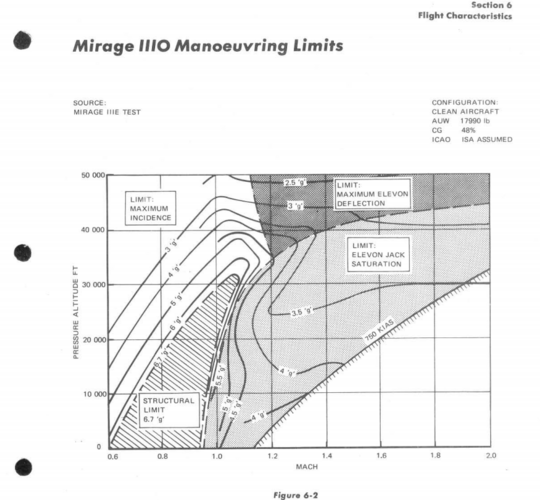
@TomcatViP I recognize that page from the Mirage IIIO performance manual on Avialogs.com (great site by the way, free sign up)… so no it’s for the actual Atar-powered Mirage IIIO in RAAF service.
- Joined
- 27 December 2005
- Messages
- 17,711
- Reaction score
- 26,160
This analysis is correct for Navy F-4 as it has Sparrow missiles for head-on capability, so the Red Top head-on capability is less relevant than its greater size (carrier takeoff weight) and cost.
One thing that should be so oblivious that but I somehow overlooked: Even though early IR guided missiles are not resistance to flares, all 3 fighters: Mirage III, Lightning F6, F-5E none of them has RWR and chaff/flares dispenser
Argentina didn't became user of the IIIC until the end of the war, where Israel supplied them under Peruvian flags (so no-one would notice that they got a few more numbers to supply the units lost in the war, 11+2 lost, 19+3 CJ received)The Falklands are interesting, because Argentina had Israel former III-C and Neshers - which had chopped arab aviations to bits twice, in the air and on the ground - except with guns and in clear weather. And rather close from home, Israel being so small...
Facing them were SHARs and at first glance they should have been chopped liver... even in dogfight and with guns, they may have suffered. In fact the Harrier had never been used as fighter, nor even created for that job. P.1154 maybe but not P.1127.
But they had a lethal weapon: the AIM-9L. Plus carrier decks nearby when Argentina was so far away. And that was more than enough to turn the odds against the Mirages (and smart Shackey Ward, too).
Israeli Mirages (even second-hand), may have been legends - but AIM-9L got the best of them and become a legend too.
On the first day of the war the Mirages came very high to save fuel and eventually beat the hell of the SHARs using their afterburners to a speed advantage.
The smart brits simply refused to fight, basically saying "So, what ? a Mirage at high altitude can't bomb the ships efficiently, so not a threat. So let's see how long you can loiter high there - we don't care."
The Argentinian pilots fell into the trap, got down to fight the SHARs or bomb the ships... and got kicked by the SHARs no longer at a disavantage.
(supersonic ? are you sure ? not at this height. Ah, wait, you have an afterburner and we have none.
Lesson 1 we don't need afterburner at low and medium height to beat you
Lesson 2 if you lit your AB and go supersonic, kiss goodbye to your return fuel.
But please, go ahead, make my day... lit your AB." )
What is noticeable is that the Argentinian pilots did not tried firing R-530 at short or medium range.
Bottom line: the missile was draggy even with only one carried on the centerline - in place of a big fuel tank; plus its efficiency was abysmal. So they didn't even tried.
And they had AIM-9s, too, but the antiquated AIM-9B with the stupid primitive seeker that locked on nothing or... everything but the ennemy exhaust.
In a sense, the first Mirage that got a radar good enough and a -530 good enough and in decent number (two) - was the Mirage F1C-200 with the Cyrano IV and two Super 530F under the wings. Still not a Phantom missile truck, but getting closer.
Mirage III with Cyrano II and 1*R-530 on the centerline was rather hopeless.
The Falklands war (merely a month before the Beka'a "turkey shot") is one of the first air war were missiles managed to shine.
(Vietnam I know had tons of AAMs fired - but reliability rates and kills were desperately low...)
What the FAA had were Mirage IIIEs, The Israeli Nesher (also known as Dagger) and the 10 Peruvian Mirage VPs (that did not participate in the conflict).
The tale of the 2 models (Dagger and IIIEA) can often be described in simple words as:
- IIIE was at its maximum range, thus having an extremely limited time over the islands, its main purpose wasn't to engage. Armed with 530 and 550.
- The Daggers were the ones to take "the heavy load" along with the Skyhawks, who packed to the brim with fuel and bombs suddenly became...a flying brick... its only AAMs were the Shafrir 2s.
In cases where the attackers got caught, in few occasions they could survive, ether by another Number of Mirages arriving and "scaring away" the harriers, or by outrunning them. Nonetheless, the Harriers would credit themselves with the destruction of 10 mirages (1 E and 9 Daggers), a lot...but not enough to stop the Argentine Aerial offensive or neglect the major attacks.
Now that you mentioned the IIIC...there is an interesting thing about them in Argentine Service...You see, the original IIIC used the ATAR 9B, while the examples that arrived after the war used the 9C, which modified the center of gravity (harder to control at lower altitudes) and it made it a bit more agile than in its original configuration.
I'll put it here as a suggestion for a next episode of this excellent thread:

 theaviationgeekclub.com
theaviationgeekclub.com
The MiG-28 has gained the right to be an official designation in the Soviet numbering system!

Soviet Pilot who test flew captured F-5 against MiG-21, MiG-23 explains why the Tiger beat the Fishbed, Flogger in every engagement - The Aviation Geek Club
Soviet Pilot who test flew captured F-5 against MiG-21, MiG-23 explains why the Tiger beat the Fishbed, Flogger in every engagement
The MiG-28 has gained the right to be an official designation in the Soviet numbering system!
- Joined
- 27 September 2006
- Messages
- 6,399
- Reaction score
- 6,780
All three could fight with guns/cannon. The Lightning, Mirage, Freedom Fighter (Mig 28) fight off must be possible on one of the numerous air combat simulation games available.
This old paper simulation from the 1970s is still out there

 boardgamegeek.com
boardgamegeek.com
This old paper simulation from the 1970s is still out there

Foxbat & Phantom: Tactical Aerial Combat in the 1970's
Cold War conflicts fought out, jet versus jet, with missiles, guns, and radar.
Attachments
Last edited:
Vanessa1402
ACCESS: Confidential
- Joined
- 10 April 2021
- Messages
- 136
- Reaction score
- 67
very nice source with insightful pilot comments, I just wish they can elaborate why Mig-21 and Mig-23 can't abuse vertical fighter against F-5E with their much greater accelerationI'll put it here as a suggestion for a next episode of this excellent thread:

Soviet Pilot who test flew captured F-5 against MiG-21, MiG-23 explains why the Tiger beat the Fishbed, Flogger in every engagement - The Aviation Geek Club
Soviet Pilot who test flew captured F-5 against MiG-21, MiG-23 explains why the Tiger beat the Fishbed, Flogger in every engagementtheaviationgeekclub.com
The MiG-28 has gained the right to be an official designation in the Soviet numbering system!
@Vanessa1402 : I see this as related to the conditions of engagement where both fighters see their speeds drop gradually. If both maintain a relatively high speed, the fact that the F-5 has better aerodynamics makes it a tighter game where there is no quick victory. But when the speed drop, this also means that the Migs consume a greater fraction of the thrust available from their engines to compensate for the drag . See the problem that pure deltas have in a turning fight (the trowel effect).
SuperSoakingAMX
ACCESS: Restricted
- Joined
- 28 September 2021
- Messages
- 3
- Reaction score
- 1
III E had RWRMirage III, Lightning F6, F-5E none of them has RWR and chaff/flares dispenser
As seen in the manual, under the name "indicateur de radar"
Similar threads
-
-
English Electric Lightning - Genesis and Projects by Tony Wilson
- Started by Schneiderman
- Replies: 15
-
Speculative Mirage III upgrade path for a fictitious nation
- Started by Blackscorpy
- Replies: 18
-
-
Spanish Mirage III EE/ED (C.15) upgrade program
- Started by NoBarrelRolls
- Replies: 10





